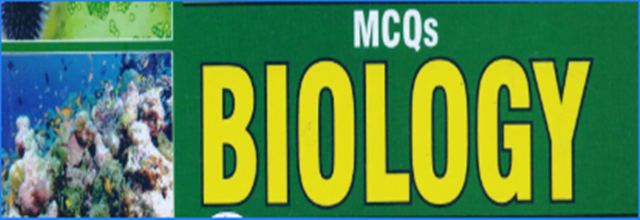Biology Solved MCQS for KMU CAT Entry Test 2025 Preparation download online practice tests in pdf. KMU CAT Test MCQS with Answers pdf download and preparation book for 2025 test.
Q.1 The function of nucleolus is to make:
A) rDNA B) RNA C) Ribosomes D) Chromosomes
Q.2 Lipid metabolism is the function of:
A) Mitochondria B) RER C) Sarcoplasmic reticulum D) SER
Q.3 The enzymes of lysosomes are synthesized on:
A) RER B) Chloroplast C) SER D) Golgi Apparatus
Q.4 Centrioles are made up of ______ microtubules:
A) 9 B) 3 C) 27 D) 12
Q.5 ______ is most abundant carbohydrate in nature.
A) Waxes B) Starch C) Glycerol D) Cellulose
Q.6 Which of the following is a keto sugar:
A) Glyceraldehyde B) Ribose C) Dihydroxy-acetone D) Glucose
Q.7 Amino acid in which the R-group is hydrogen is:
A) Glycine B) Leucine C) Alanine D) Valine
Q.8 Acyl-glycerols like fats and oils are esters formed by condensation reaction between:
A) Fatty acids and water B) Fatty acids and glucose C) Fatty acids and alcohols D) Fatty acids and phosphates
Q.9 Which of the following is purine:
A) Guanine B) Thymine C) Cytosine D) Uracil
Q.10 All coenzymes are derived from:
A) Proteins C) Carbohydrate
B) Nucleic acids D) Vitamins
Q.11 Reverse transcription is used to make DNA copies of:
A) Host RNA C) Host DNA
B) Viral RNA D) Viral DNA
Q.12 Antibiotics are produced by fungi and certain bacteria of group:
A) Actinomycetes C) Ascomycetes
B) Oomycetes D) Basidiomycetes
Q.13 Which statement about bacteria is true:
A) Gram positive bacteria have more lipids in their cell wall
B) Gram negative bacteria have more lipids in their cell wall
C) Lipids are absent in cell wall of both gram positive and negative bacteria
D) Both have equal amount of lipids
Q.14 Fungi which cause thrush in humans:
A) Sarcomeres C) Lovastatin
B) Candidiasis D) Aspergillus
Q.15 Sleeping sickness in humans is caused by:
A) Trypanosoma C) Anopheles
B) Plasmodium D) Andes
Read Also;
Most Important Biology 80 MCQS with Answers
Q.16 Schistosoma is a parasite that lives in the _____ of the host.
A) Intestine C) Liver
B) Kidney D) Blood
Q.17 The cavity between body wall and alimentary canal is:
A) Coelom C) Endoderm
B) Mesoderm D) Mesoglea
Q.18 The total inside capacity of lungs is _____ for man.
A) 6.7 liters C) 7 liters
B) 2.5 liters D) 5 liters
Q.19 The average life span of red blood cell is about:
A) Four months C) Five months
B) Two months D) One month
Q.20 The lymphatic vessels of the body empty the lymph into blood stream at the:
A) Abdominal vein C) Jugular vein
B) Subclavian vein D) Bile duct
Q.21 Right atrium is separated from right ventricle by:
A) Tricuspid valve C) Semilunar valve
B) Bicuspid valve D) Septum
Q.22 Site of filtration in nephron is:
A) Glomerulus and Bowman’s capsule C) Ascending and descending arm
B) Proximal and Distal end D) Loop of Henle
Q.23 L-dopa or Levodopa is used to get some relief from??
A) Epilepsy C) Parkinson’s disease
B) Alzheimer’s disease D) Dementia
Q.24 Spermatogonia differentiate directly into?
A) Primary spermatocytes C) Spermatozoa
B) Secondary spermatocytes D) Spermatids
Q.25 Treponema palladium causes?
A) AIDS C) Syphilis
B) Genital herpes D) Gonorrhea
Q.26 What is the location of interstitial cells in testes?
A) Inside the seminiferous tubules C) Among the germinal epithelial cells
B) Between the seminiferous tubules D) Around the testes
Q.27 A type of cells in human testes which produce testosterone are called?
A) Germ cells C) Interstitial cells
B) Sertoli cells D) Spermatocytes
Q.28 The hormone produced from corpus luteum is:
A) Prolactin C) Progesterone
B) FSH D) LH
Q.29 The length of myofibril from one Z-band to the next is described as:
A) Sarcolemma C) Sarcomere
B) Sarcoplasm D) Muscle fiber
Q.30 The phage commonly used as a vector in genetic engineering is?
A) Lambda phage C) T2 phage
B) Gamma phage D) T4 phage
Q.210 Restriction endonucleases are naturally occurring enzymes of:
A) Viruses C) Fungi
B) Bacteria D) Plants
Q.31 In an ecosystem mycorrhizae are an example of:
A) Predation C) Mutualism
B) Symbiosis D) Parasitism
Q.32 As a result of destruction of ozone layer there is significant increase in:
A) Ultra-violet radiations C) Nitrogen oxide
B) Greenhouse gases D) Sulphur oxide
Q.33 Higher rate of a biological activity in a nutrient rich pond water is called:
A) Water pollution C) Eutrophication
B) Air pollution D) Industrial effects
Q.34 Living part of ecosystem is:
A) lithosphere C) Community
B) Hydrosphere D) Biosphere
Q.35 A living association between two living organisms of different species which is beneficial to both
the partners is called:
A) Commensalism C) Mutualism
B) Parasitism D) Predation
Q.36 The structures which are reduced during the course of evolution and have no apparent function
are called:
A) Regenerated organs C) Saltatory organs
B) Vestigial organs D) Useless organs
Q.37 When a gene suppresses the effect of another gene at another locus the phenomenon is termed
as:
A) Over dominance C) Epistasis
B) Pleiotropy D) Co-dominance
Q.38 Phenylketonuria is an example of:
A) Polyploidy C) Inversion
B) Transmutation D) Point mutation
Q.39 A situation in which one gene affects two or more unrelated characters is called:
A) Epistasis C) Dominance relation
B) Pleiotropy D) Polygenes
Q.40 The mutation which causes change in the sequence of DNA is called:
A) Point mutation C) Deletion
B) Chromosomal mutation D) Inversion

